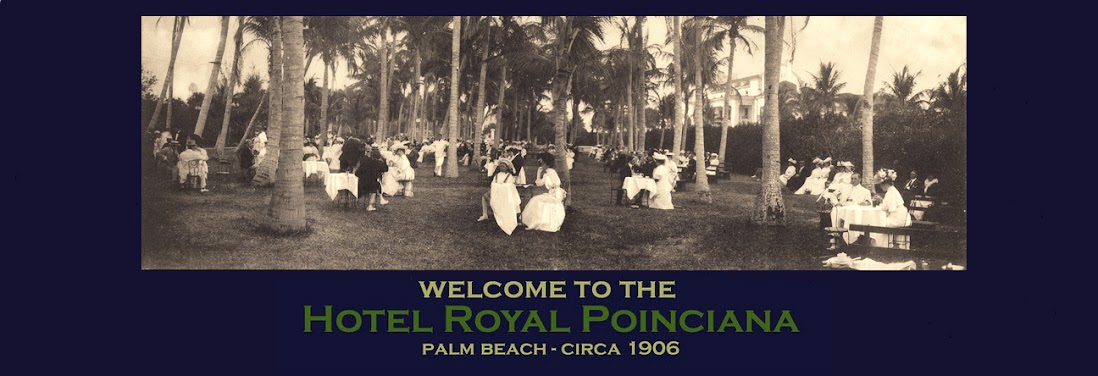The HRP (Hotel Royal Poinciana), circa 1900. The main entrance to the hotel was here on the west side facing the lake. This picture was taken from the south end of the hotel, renowned for the colorful gardens that gave winter visitors a respite from the frozen north. Henry Flagler's "Whitehall,' completed a year or so after this picture was taken stands just behind where the photographer stood. Click to enlarge! (Library of Congress photo)
There were 1,150 guest rooms. The main dining room could feed 1600 guests at one time. With seven miles of corridor running throughout six stories, the Hotel Royal Poinciana was the largest wooden structure in the world. The wealthiest rich and famous flocked to Henry Morrison Flagler's "Newport of the South" to make the Royal Poinciana their Winter home. Thousands of local citizens were employed to keep the hotel operating. Both Palm Beach and West Palm Beach owne their existence to Flagler's vision.
The mammoth Hotel Royal Poinciana opened in 1894 and stood on the shore of Lake Worth for just over forty years. It survived major hurricanes and the 1925 fire that destroyed the Breakers and Palm Beach hotels. But it couldn't recover from the economic bust that started with the market crash of 1929 or the changing tastes of the times.
In a sense, the Poinciana became one more victim of the 1925 fire when the new Breakers Hotel reopened less than a year later. The aging Poinciana was no match for this new masterpiece of Italian Renaissance style that was not only "fireproof" but offered a bathroom in every guest room. The end came fast for the Hotel Royal Poinciana.
Just a decade after the Breakers reopened the last pieces of the hotel were hauled away. More than 500 homes and at least one church were built from the scrap.
We know more about Titanic than the Poinciana! (con't)
There were 1,150 guest rooms. The main dining room could feed 1600 guests at one time. With seven miles of corridor running throughout six stories, the Hotel Royal Poinciana was the largest wooden structure in the world. The wealthiest rich and famous flocked to Henry Morrison Flagler's "Newport of the South" to make the Royal Poinciana their Winter home. Thousands of local citizens were employed to keep the hotel operating. Both Palm Beach and West Palm Beach owne their existence to Flagler's vision.
The mammoth Hotel Royal Poinciana opened in 1894 and stood on the shore of Lake Worth for just over forty years. It survived major hurricanes and the 1925 fire that destroyed the Breakers and Palm Beach hotels. But it couldn't recover from the economic bust that started with the market crash of 1929 or the changing tastes of the times.
In a sense, the Poinciana became one more victim of the 1925 fire when the new Breakers Hotel reopened less than a year later. The aging Poinciana was no match for this new masterpiece of Italian Renaissance style that was not only "fireproof" but offered a bathroom in every guest room. The end came fast for the Hotel Royal Poinciana.
Just a decade after the Breakers reopened the last pieces of the hotel were hauled away. More than 500 homes and at least one church were built from the scrap.
We know more about Titanic than the Poinciana! (con't)




.jpg)





.jpg)
































